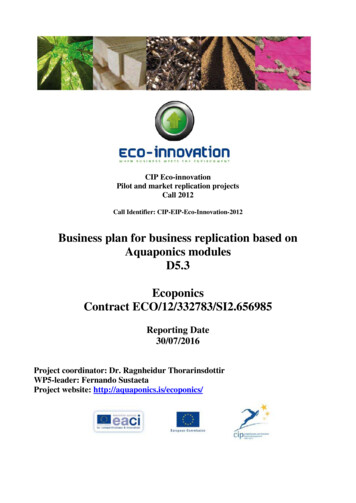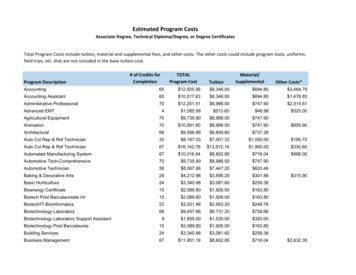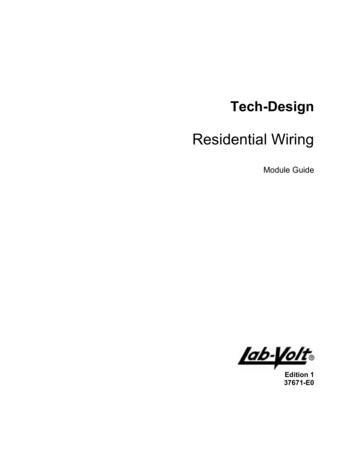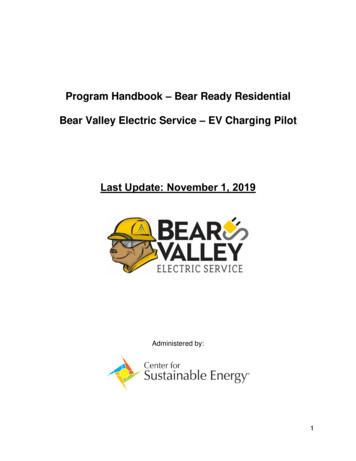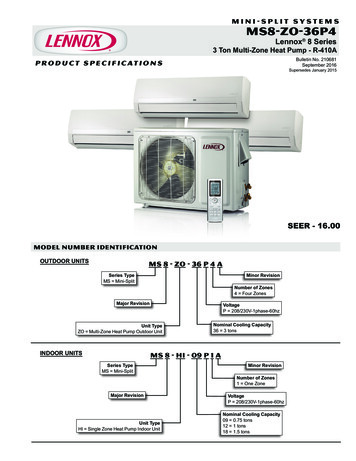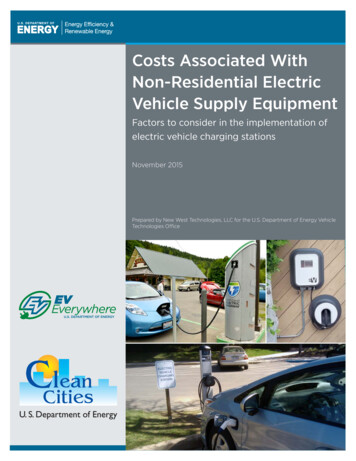
Transcription
Costs Associated WithNon-Residential ElectricVehicle Supply EquipmentFactors to consider in the implementation ofelectric vehicle charging stationsNovember 2015Prepared by New West Technologies, LLC for the U.S. Department of Energy VehicleTechnologies Office
AcknowledgmentsThis report was produced with funding from The U.S. Department of Energy’s (DOE) Clean Cities program.DOE’s Clean Cities Co-director Linda Bluestein and Workplace Charging Challenge Coordinator SarahOlexsak provided direction and overall guidance for this pursuit. This report was made possible by input fromnational laboratories, utilities, electricians, electric vehicle supply equipment manufacturers, and chargingstation hosts. The authors are grateful for all the information provided by subject matter experts and would liketo extend a special thank you to Jim Francfort, Idaho National Laboratory; Ted Bohn and Dan Santini, ArgonneNational Laboratory; Charlie Botsford, AeroVironment; and Randy Schimka, San Diego Gas and Electric. Thewide variety of the reviews greatly added to the robustness and accuracy of this report, but any errors hereinare solely the authors’ responsibilities.AuthorsMargaret Smith, New West Technologies LLCJonathan Castellano, New West Technologies LLC2Acknowledgments
Executive SummaryAs more drivers purchase plug-in electric vehicles (PEVs), there is a growing need for a network of electricvehicle supply equipment (EVSE) to provide power to those vehicles. PEV drivers will primarily chargetheir vehicles using residential EVSE, but there is also a need for non-residential EVSE in workplace, public,and fleet settings. This report provides information about the costs associated with purchasing, installing,and owning non-residential EVSE. Cost information is compiled from various studies around the country, aswell as input from EVSE owners, manufacturers, installers, and utilities. The cost of a single port EVSE unitranges from 300- 1,500 for Level 1, 400- 6,500 for Level 2, and 10,000- 40,000 for DC fast charging.Installation costs vary greatly from site to site with a ballpark cost range of 0- 3,000 for Level 1, 600 12,700 for Level 2, and 4,000- 51,000 for DC fast charging.Many factors lead to highly variable costs associated with EVSE. The report includes example cost ranges forboth different types and applications of EVSE as well as the cost factors that can influence whether a particularEVSE unit or installation will fall on the lower or higher end of the cost range. Employers, business owners,and fleet operators can find the best EVSE solution for a specific site by evaluating needs and opportunities,then strategically determining the optimal number of EVSE, types of features, and location.In general, there is an industry consensus that the cost of EVSE units is trending downwards and will continueto decrease. However, installation costs are highly variable and there is no consensus among industrystakeholders about the direction of future installation costs. In addition, state and local incentives in manyplaces encourage EVSE installation through funding and technical assistance.While the available cost information from past EVSE installations provides a wide ballpark range for futureinstallations, the only way to determine a cost estimate for a specific site is to contact the utility, EVSEmanufacturers, and EVSE installers for a site assessment. Clean Cities coalitions around the country bringtogether a network of contacts in the electric vehicle industry and are a good starting place for identifying localcontacts. To find a local Clean Cities coalition, visit cleancities.energy.gov.Executive Summary3
Table of ContentsIntroduction .6EVSE Overview.6EVSE Costs Overview . 7EVSE Unit Costs.9EVSE Unit Cost Drivers.9EVSE Unit Costs Ranges and Examples.11Installation Costs .13Installation Cost Drivers.13Installation Cost Ranges and Examples.17Operation and Maintenance (O&M) Costs. 20Electricity Consumption Charges. 20Electricity Demand Charges. 20Network Fees.21Maintenance and Repair.21Station Management.22Additional Cost Factors.22Incentives.22Permitting and Inspection.24Workplace, Public, and Fleet EVSE Costs.24Cost Factors to Consider for Workplace Charging.25Cost Factors to Consider For Public Charging.26Cost Factors to Consider for Fleet Charging.28Summary. 29Tips for Minimizing EVSE Costs. 29Additional Resources.32Appendix A: Acronyms, Definitions, and Equipment Overview.33Appendix B: Codes and Standards.37Appendix C: Electricity Consumption Examples.38Appendix D: State and Utility EVSE Incentives .39Appendix E: References. 424Table of Contents
List of FiguresFigure 1 PEV Charging Pyramid.6Figure 2 AC Level 1 and Level 2 Charging Schematic.6Figure 3 DC Fast Charging Schematic.6Figure 4 Charging Level Descriptions . 7Figure 5 Ballpark Cost Ranges for Level 2 EVSE .12Figure 6 Average Installation Cost for Publicly Accessible Level 2 EVSE. 16Figure 7 Distribution of Per Unit Publicly Accessible Installation Costs. 18Figure 8 Distribution of Per Unit Workplace Level 2 Installation Costs. 19Figure 9 Distribution of DCFC Installation Costs. 19Figure 10 State EVSE Incentives Map.23Figure 11 Level 2 Average Installation Cost by Setting.25List of TablesTable 1 EVSE Unit Costs.11Table 2 Ballpark EVSE Installation Costs.17Table 3 Example EVSE Incentives.23Table 4 Ballpark EVSE Unit and Installation Costs. 30Table 5 Connector Standards, Charging Levels, and Vehicles. 36List of Figures5
IntroductionThis document is designed to help employers, business owners, and fleet operators understand the costsassociated with installing, operating, and maintaining electric vehicle supply equipment (EVSE), also knownas electric vehicle “charging stations.” It provides an overview of the equipment and processes neededto install EVSE and offers representative examples of cost ranges. Theinformation presented is based on data collected from various studies aroundthe country, as well as input from EVSE owners, manufacturers, installers,and utilities.Many plug-in electric vehicle (PEV) drivers charge their vehicles athome using residential charging located at single family homes ormulti-family complexes such as apartments and condominiums.This report however, focuses on the costs of non-residentialstations such as public access, workplace, and fleet stationsshown in the middle and top of the pyramid in Figure 11.Increasing the number of EVSE available in these nonresidential locations can help expand the electric drivingrange for PEVs, as well as enable PEV ownership fordrivers without access to home charging. Public accesscharging stations are available for use by the generalpublic or patrons/visitors to businesses, institutions,and municipalities. Workplace charging stationsare intended for the use of employees or guestsof a particular organization. Fleet stations areprimarily used by business, government, or otherfleet vehicles and are located at commercial,Figure 1. This pyramid illustrates how likely PEV drivers are togovernment, or other non-residential parkingneed and use each type of charging infrastructure. Image fromArgonne National Laboratory.locations.EVSE OverviewEVSE consists of all theequipment needed to deliverelectrical energy froman electricity source to aPEV battery. The EVSEcommunicates with the PEV toensure that the plug is securelyconnected to the vehiclereceptacle before supplying asafe flow of electricity. Thereare three primary types ofEVSE. Two types—AC Level1 and AC Level 2—providealternating current (AC) to thevehicle, which the vehicle’sonboard charging equipmentFigure 2. AC Level 1 and 2 chargingschematic. Image from Dean Armstrong,Figure 3. DC fast chargingschematic. Image from DeanNational Renewable Energy Laboratory(NREL).Armstrong, NREL.1 This is a companion resource to the Clean Cities’ Plug-In Electric Vehicle Handbook series available at www.cleancities.energy.gov/publications. These handbooksprovide information about PEVs, benefits of owning EVSE, and the process for installing EVSE.6Introduction
converts to the direct current (DC) needed to charge the batteries. Note that for AC Level 1 and 2 the chargerbuilt directly into the car is charging the battery. The third type—DC fast charging—provides DC electricitydirectly to the vehicle’s battery. The charger is located off-board the vehicle, in the DC fast charger (DCFC).The charging schematics in Figures 2 and 3 depict the components involved with charging a PEV.The differences in supply power and charging time for AC Level 1, AC Level 2, and DC fast charging areillustrated in Figure 4. The supply power is a product of the voltage in volts (V) and current in amperes(A). EVSE units are available in different amperage ratings which correlate to charging power. The vehiclecharging time depends on the state of charge of the battery, the power coming from the EVSE, and the ratea vehicle can accept power, which may be lower than the supply power. The EVSE’s dedicated circuit mustbe rated for a larger current than the EVSE continuous load rating (at least 125% larger) to conform to theNational Electrical Code (NEC). For instance, a Level 2 EVSE rated for 30A continuous load will requirea 40A circuit. Please refer to Appendix A for more information about EVSE charging types, PEV chargingcomponents, electrical hardware, and EVSE connector standards.Charging LevelAC Level 1Vehicle Range Added perCharging Time and Power4 mi/hour @ 1.4kW6 mi/hour @ 1.9kWSupply Power120VAC/20A(12-16A continuous)10 mi/hour @ 3.4kWAC Level 220 mi/hour @ 6.6kW208/240VAC/20-100A(16-80A continuous)60 mi/hour @ 19.2 kW24 mi/20minutes @24kWDC Fast Charging50 mi/20minutes @50kW90 mi/20minutes @90kW208/480VAC 3-phase(input current proportional tooutput power; 20-400A AC)Figure 4. Description of charging level supply power and charging times. The power coming from the EVSEdepends on the voltage from the electrical service and the EVSE amperage rating.EVSE Costs OverviewThe costs associated with installing and operating EVSE can vary widely, depending on the EVSE unitfeatures, site location, available electrical capacity, and labor costs. It is difficult to compare or predict EVSEcosts since actual costs of a given project will depend on the specific needs and constraints of the stationand its users. The cost ranges shown in this document should only be used for the purposes of preliminaryinvestigation of PEV charging infrastructure and not as a tool for estimating the cost of an individual project.To obtain estimates for a specific project, contact EVSE manufacturers and electricians2. The installation costspresented in this report are primarily from early installations of the technology that occurred between 20092 For more information, consult your local Clean Cities coalition. Contact information can be found at afdc.energy.gov/cleancities/coalitions/coalition contacts.phpEVSE Costs Overview7
and 2013 because robust data sets of newer installations are not yet available. As the PEV market develops andmatures in the future, installation costs may vary from those presented herein.This report draws from published studies andinterviews with industry experts to provide costapproximations across a range of EVSE types,geographic locations, and complexity. Two recent androbust sources of information are the EV Project and astudy by the Electric Power Research Institute (EPRI).The EV Project, funded by the U.S. Department ofEnergy (DOE) and private partners, deployed Level 2and DCFC EVSE from 2011 to 2013. Idaho NationalLaboratory (INL) has cost data for about 2,500 singleport Level 2 EVSE (pictured in Photo 1) and over 100dual port DCFC installed for non-residential use.Photo 1. This series of Level 2 EVSE were installed by theEV Project. Photo from INL.EPRI conducted a study on installation costs for EVSE installed in the 2010 to 2013 timeframe. EPRI analyzed385 commercial charging sites that installed 989 Level 2 EVSE including both single port and dual port EVSE(EPRI 2013).The West Coast Electric Highway (WCEH) is another public-private partnership with cost information forDCFC installations. The WCEH installed 56 DCFC stations across Oregon and Washington between 2011 to2015.The costs associated with owning and operating EVSE include: 8EVSE unit hardware cost, which may include:-- EVSE unit-- optional EVSE equipment (e.g., RFID card reader);Installation cost, which may include:-- contractor labor and materials for* connecting EVSE to the electrical service (e.g., panel work,trenching/boring, and repaving parking)* new electrical service or upgrades (e.g., transformers)* meeting Americans with Disabilities Act (ADA)requirements* traffic protection* signage* lighting-- permitting and inspection-- engineering review and drawings;Additional capital cost, which may include:-- hardware extended warranty-- repair labor warranty-- land/parking space purchase or lease;Incentive credits (to reduce equipment or installation costs), whichmay include:-- rebates-- tax credits/exemptions-- grants-- loansEVSE Costs OverviewPhoto 2. Pedestal-mounted EVSEinstalled by the City of Raleigh, N.C.,for free public use. Photo from KathyBoyer, NREL 18520
Operation and maintenance cost-- electricity consumption and demand charges-- EVSE network subscription to enable additional features-- management time-- billing transaction costs-- preventative and corrective maintenance on EVSE unit-- repairs (scheduled and unscheduled).A site owner may also want to consider the upfront costs that are incurred to identify viable locations for anEVSE station. This may include fees for consultants, site evaluations, or feasibility studies needed to assess theelectrical capacity and location of utility service lines serving a given facility or site.EVSE Unit CostsEVSE units are available from many different manufacturers with a variety of designs and features. Featuresrange from a simple unit that turns on and off to units that collect data, communicate to users, and providea billing option for the owner of the charging station. The type and quantity of EVSE chosen for a site willdepend on the intended users, site specific conditions, data management, and business case for the station.When purchasing an EVSE unit, an owner may choose to also purchase an extended warranty to coverpotential repairs beyond the standard unit warranty period.EVSE Unit Cost DriversEVSE unit costs are affected by the charging level, number of ports, communications system, data analysis,and other features.Charging Level and Amperage RatingAll PEVs have a cordset that plugs into a Level1 outlet (110-120V) and connects to the vehicle’scharging port with a connector as shown in Photo 3.Providing Level 1 charging is the most inexpensivecharging option. It can range from offering anoutlet for a PEV driver to plug in a Level 1 cordsetto offering an EVSE with a connector. Level 2units are the midrange cost option and DCFC isthe highest cost tier. The EVSE charging powerPhoto 3. This EVSE cordset can be stored in a vehicledepends on the voltage from the electrical serviceand plugged into an available electrical outlet. It canand the EVSE unit amperage rating. Level 1 EVSEbe used for Level 1 or Level 2 charging. Photo fromare rated from 12-16A continuous, Level 2 EVSEAeroVironment.are commonly rated from 16-48A continuous, andDCFC typically have a maximum of 60-200A.An increase in charging power also increases the cost of the unit due to the higher manufacturing cost toaccommodate the higher amperage (e.g., a 48A Level 2 EVSE costs more than a 30A Level 2 EVSE).Charging PortsSingle port EVSE units provide access for only one vehicle to charge at a time. Multiple port EVSE units(commonly 2, 3, or 4 ports) are available to allow multiple vehicles to charge simultaneously or sequentially.DCFC connectors (the part of the EVSE that is inserted into the vehicle inlet) can meet either an SAE standardEVSE Unit Costs9
or CHAdeMO standard3. A dual port DCFC may offer multiple EVSE connector standards at one unit, but onlyallow one vehicle to charge at a time. Careful consideration should be given to these options so that the EVSEis compatible with the PEVs that will be using it as well as potential future estimated usage. Multiple port unitsare more expensive than single port units but both the unit cost and the installation cost are less expensive on aper-port basis for multiple port units.Type of Mounting SystemUnits are typically available as either wall mounted(shown in Photo 4) or pedestal mounted (shown in Photo5). Ceiling mounted units are also available but are morecommon for residential use. A pedestal mounted unitcosts about 500- 700 more than a wall mounted one dueto the material and manufacturing cost of the pedestal.There is also an additional construction cost for installinga pedestal mounted unit (e.g., pouring a concrete pad atthe base). Typically, site owners choose a wall mountedunit if the parking spots to be used for charging are closeto a wall, since the unit and installation cost less thana pedestal mount. However, pedestal mounted unitsprovide more design flexibility, such as the ability toplace the EVSE in the middle of a parking lot or in frontof a sidewalk. They can also hold multiple EVSE units.In the EV Project, the averageinstallation cost for a wall mountedLevel 2 EVSE unit ( 2,035) is 37%lower than the average installationcost for a pedestal unit ( 3,209).Additional FeaturesPhoto 4. Wall mounted EVSE installed by theNew York Power Authority for employee charging.Photo from NY Power Authority, NREL 26468.Photo 5. NREL employee plugging in his electricvehicle in one of the 36 EVSE in the NREL parkinggarage. Photo from Dennis Schroder/NREL, NREL 26675.The most basic EVSE unit will be UL (Underwriters Laboratories) approved to safely supply electricity to thevehicle and provide lights to show when it has started and stopped charging. More sophisticated (“smarter”)units are available with a variety of additional features described below, although these increase the cost of theEVSE unit. Communications capabilities enable different levels of data communication with the user, site host,utility grid, and the Internet. For instance, a user may be able to use a mobile application to remotelyfind an EVSE and check if it is available for use or out of service. Also, site hosts may be able toremotely update pricing, push messages out to users, and control other charging parameters. Access control restricts the use of EVSE to specific users. Systems range from a simple keypad orpadlock to more complex, (e.g., granting access through radio-frequency identification (RFID) cardsor mobile phone applications.) Point of sale (POS) functionally allows units to recover costs/fees associated with charging events.They could include a credit card reader, RFID reader, or mobile phone application.3 See Appendix A: Acronyms, Definitions, and Equipment Overview for more information about EVSE connectors and standards.10EVSE Unit Costs
Energy monitoring tracks the EVSE’s energy consumption and provides reports on greenhousegas emissions reductions. This can help site hosts show how the EVSE is contributing to theirsustainability goals.Energy management and demand response optimizes load management to maximize chargingduring low rate periods and minimize charging during high-rate periods. For instance, an EVSE can beprogrammed to only charge a vehicle during predetermined times.Advanced display screen provides user communication, advertising, and brand promotion.Retractable cord protects the cord and connector from damage and freezing, as well as reduces therisk of tripping on the cord.Automated diagnostics are used to troubleshoot issues or malfunctions that occur with the EVSE.Networked or Non-NetworkedEVSE units can be networked or non-networked. Networked units are connected to the Internet via a cableor wireless technology and send data to a network host’s computer server, also known as the “back office.”They provide the ability to remotely access availability of EVSE in real-time. Non-networked units are notconnected to the Internet. They provide basic charging functionality without advanced communications ormonitoring capabilities, so the equipment is priced lower than networked EVSE. Secondary systems can bepurchased to incorporate additional features such as access control, payment systems, and data collection into anon-networked unit. These secondary systems can be useful if a grant or incentive requires data collection butthe site host wants to purchase a non-networked EVSE.Networked EVSE are typically part of a charging network, which is a group of EVSE units with access controland payment systems that are managed by a single organization. A sampling of the major networks includesAeroVironment, Blink, ChargePoint, GE WattStation Connect, Greenlots SKY, NRG eVgo, SemaConnect,and Tesla. Each charging network has its own PEV driver payment model, the most common being monthlysubscriptions, pay-as-you-go (pay per charge), and free (free to charge; no subscription fee required). Benefitsof a site host paying for a charging network can include charging station visibility and availability for drivers,energy monitoring, station usage analysis, automated payments, automated diagnostics, access control, andcustomer support. A site host may set pricing policies using a networked EVSE (e.g., employees consumeelectricity for free and visitors pay a fee).EVSE Unit Costs Ranges and ExamplesEVSE unit costs have decreased over the past five years as the PEV industry has matured and manufacturershave improved EVSE technology. The EVSE unit costs presented in Table 1 are based on single port productsavailable in 2014 and 2015. EVSE with multiple ports may have a price higher than these ranges.EVSE Unit CostsEVSE Type(single port)EVSE Unit Cost RangeLevel 1 300- 1,500Level 2 400- 6,500DCFC 10,000- 40,000Table 1. EVSE unit cost ranges based on unitsavailable in 2015EVSE Unit Costs11
The lowest price Level 1 unit is asimple plug-in cordset costing about 300. A wall mounted cordset witha keypad for access control is at themiddle of the cost range.A hardwired Level 1 pedestalunit with access control and cablemanagement could cost closer to 1,500. A pedestal Level 1 EVSE isshown in Photo 6.Single port Level 2 units are availablespanning a 400- 6,500 cost rangedepending on the included features.Photo 6. Portland International Airport installed 42 Level 1 EVSE forWhile there is no standard EVSEemployees and airport customers. Photo from Telefonix.unit for the fleet, workplace, orpublic sites, the graphic in Figure 5illustrates example costs for sampleLevel 2 EVSE units with different tiers of additional features. The pictured examples are meant only to showhow the cost of an EVSE unit may change based on the mounting system and selected features.Ballpark Cost Ranges for Level 2 EVSEFigure 5. Ballpark cost ranges for different tiers of Level 2 EVSE units. Image from Kristina Rivenbark, New West Technologies.A low price DCFC costing approximately 10,000 would typically have low power (25-50kW) with lowcharging amperage, a single port, and no display or networking components. The lower cost for a low poweroutput is a tradeoff for a slower charging speed but it may be a good fit for the vehicles that are expected touse the DCFC. A mid-price DCFC will have higher power (50kW ), single or multiple ports, a keypad orsome other simple form of access control, and a simple display. It might also be networked and have POS. Thehighest price DCFC will have higher power (50kW ) with high charging amperage enabling multiple vehiclesto charge at once, RFID or some other advance
The differences in supply power and charging time for AC Level 1, AC Level 2, and DC fast charging are illustrated in Figure 4. The supply power is a product of the voltage in volts (V) and current in amperes (A). EVSE units are available in different amperage ratings which correlate to charging power. The vehicle

